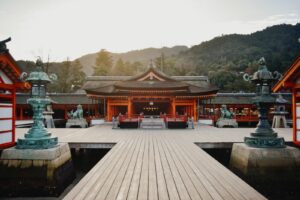
 Shrines are religious structures that are central to the Shinto religion in Japan. Shinto, which means “The Way of the Gods,” is an indigenous religion of Japan that focuses on the worship of kami, or spirits, that are believed to reside in natural objects such as trees, rocks, and rivers.
Shrines are religious structures that are central to the Shinto religion in Japan. Shinto, which means “The Way of the Gods,” is an indigenous religion of Japan that focuses on the worship of kami, or spirits, that are believed to reside in natural objects such as trees, rocks, and rivers.
Shrines are typically marked by a torii gate, which serves as the entrance to the shrine grounds. Inside the shrine grounds, visitors can perform traditional rituals such as purifying themselves with water before praying, making offerings, and making wishes.
Shrines come in many different sizes, from small neighborhood shrines to large, grand shrines that can attract millions of visitors. Some of the most famous shrines in Japan include the Ise Grand Shrine, the Meiji Shrine, and the Yasukuni Shrine.
Shrines play an important role in Japanese culture and society, serving as a place of worship, a site of traditional festivals and events, and a source of community pride and identity. They are also popular tourist attractions and offer visitors a glimpse into Japan’s rich cultural and religious heritage.
Famous Shrines in japan are as follows:
Meiji Shrine, Tokyo
Fushimi Inari Taisha, Kyoto
Yasukuni Shrine, Tokyo
Itsukushima Shrine, Hiroshima
Toshogu Shrine, Nikko
Ise Grand Shrine, Mie
Kamakura Hasedera Temple, Kamakura
Tsurugaoka Hachiman-gu Shrine, Kamakura
Atsuta Shrine, Nagoya
Heian Shrine, Kyoto.